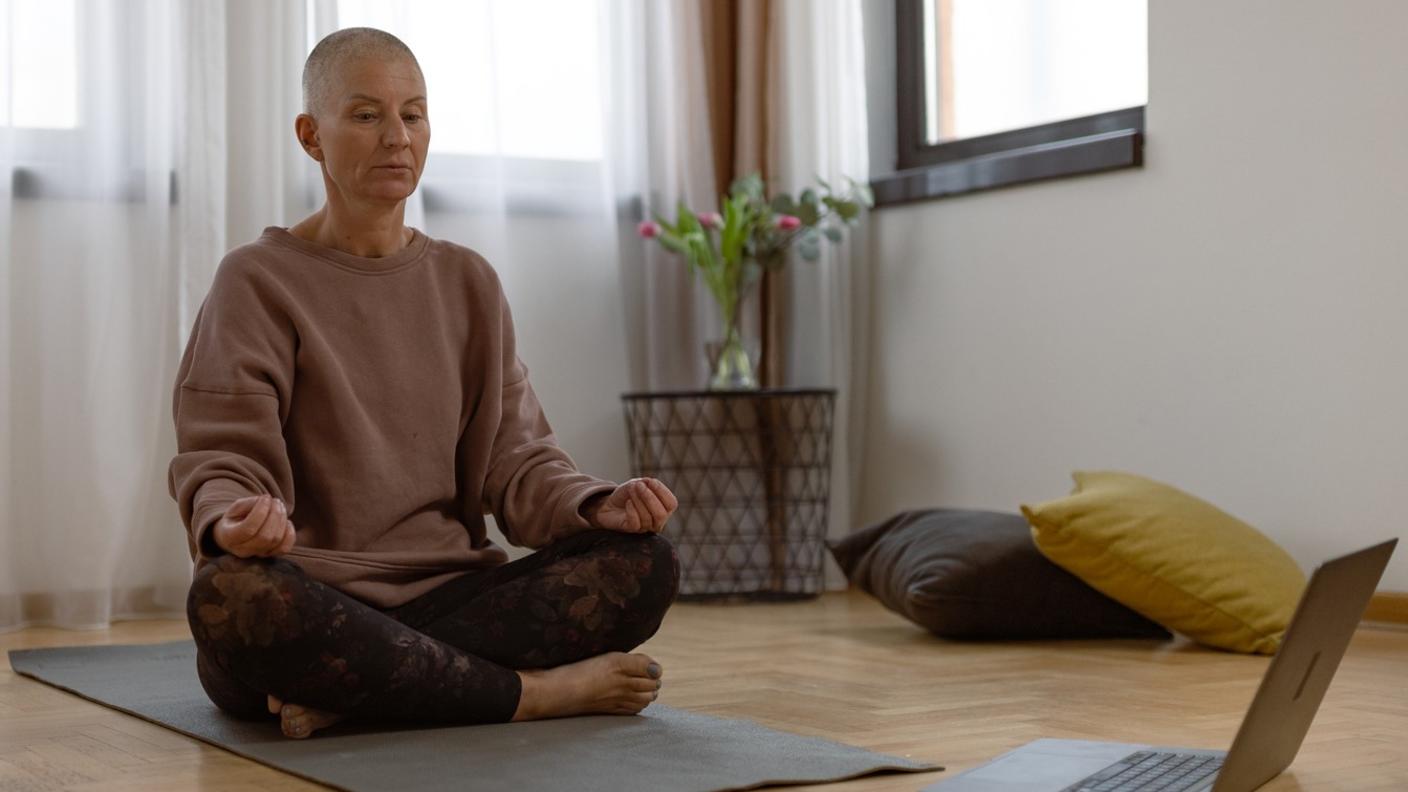Many people with cancer and their caregivers have found that doing relaxation techniques or practicing meditation and mindfulness has helped them lower stress and cope with anxiety. All are ways people try to calm themselves and feel better.
- Relaxation techniques include muscle tensing and release, breathing exercises, and guided imagery to name a few.
- In meditation, a person focuses his or her attention on something, such as an object, word, phrase, or breathing. It may help relax the body and mind and improve overall health and well-being.
- Mindfulness is a type of meditation based on the concept of being “mindful,” or having increased awareness of the present. It can be a sitting meditation that’s done in a quiet space. In this practice, you focus on your breathing or sensations in your body. When your mind wanders and thoughts pop into your head, you try to return your mind to the present moment.
Being mindful doesn’t have to be done sitting still or in silence. Some people like to do a walking meditation either outside or inside. You can also blend mindfulness into the things you do every day, like waiting in line, sitting at a bus stop, or eating. You can also be mindful while being with others.
Take the time to learn how to relax your mind and body. You could start with the exercises below and practice them when you can. Even doing just 5 or 10 minutes may help you feel better. You can also take a class, find videos on YouTube, buy a relaxation DVD or recording, or find other exercises online. There are also many online programs and apps for doing meditation. Be careful to only use well-known sources or those from medical schools or universities.
Getting Started with Relaxation Techniques
For each exercise, find a quiet place where you can rest undisturbed. Let others know you need time for yourself. Make the setting peaceful for you. For example, dim the lights and find a comfortable chair or couch.
You may find that your mind wanders, which is normal. When you notice yourself thinking of something else, gently direct your attention back to your body. Be sure to maintain your deep breathing.
Some people like to listen to slow, familiar music while they practice these exercises.
Breathing and muscle tensing
- Get into a comfortable position where you can relax your muscles. Close your eyes and clear your mind of distractions. You can sit up or lie down. If you’re lying down, you may want to put a small pillow under your neck and knees.
- Breathe deeply, at a slow and relaxing pace. Concentrate on breathing deeply and slowly, raising your belly with each breath, rather than just your chest.
- Next, go through each of your major muscle groups, tensing (squeezing) them for a few seconds and then letting go. Start at the top of your head and work your way down. Tense and relax your face and jaws, then shoulders and arms.
- Continue tensing and relaxing each muscle group as you go down (chest, lower back, buttocks, legs), ending with your feet. Focus completely on releasing all the tension from your muscles and notice the differences you feel when they are relaxed.
- When you are done, focus on the pleasant feeling of relaxation for as long as you like.
Slow rhythmic breathing
- Stare at an object or shut your eyes and think of a peaceful scene. Take a slow, deep breath.
- As you breathe in, tense your muscles. As you breathe out, relax your muscles and feel the tension leaving.
- Remain relaxed and begin breathing slowly and comfortably, taking about 9 to 12 breaths a minute. To maintain a slow, even rhythm, you can silently say to yourself, “In, one, two. Out, one, two."
- If you ever feel out of breath, take a deep breath, and continue the slow breathing.
- Each time you breathe out, feel yourself relaxing and going limp. Continue the slow, rhythmic breathing for up to 10 minutes.
- To end the session, count silently and slowly from one to three. Open your eyes. Say to yourself, “I feel alert and relaxed.” Begin moving slowly.
Imagery
Note: You may want to read this out loud and record it so you can follow along as you do the exercise. Or you could ask a friend to record it if you would rather not hear your own voice. You could also just read the exercise over a few times to remember the main tips.
Imagery usually works best with your eyes closed. To begin, create an image in your mind. For example, you may want to think of a place or activity that made you happy in the past. Explore this place or activity. Notice how calm you feel.
If you have severe pain, you may imagine yourself as a person without pain. In your image, cut the wires that send pain signals from one part of your body to another. Or you may want to imagine a ball of healing energy. Others have found the following exercise to be very helpful:
- Close your eyes and breathe slowly. As you breathe in, say silently and slowly to yourself, “In, one, two,” and as you breathe out, say “Out, one, two.” Do this for a few minutes.
- Imagine a ball of healing energy forming in your lungs or on your chest. Imagine it forming and taking shape.
- When you’re ready, imagine that the air you breathe in blows this ball of energy to the area where you feel pain. Once there, the ball heals and relaxes you. You may imagine that the ball gets bigger and bigger as it takes away more of your discomfort.
- As you breathe out, imagine the air blowing the ball away from your body. As it floats away, all of your pain goes with it.
- Repeat the last two steps each time you breathe in and out.
To end the imagery, count slowly to three, breathe in deeply, open your eyes, and say silently to yourself, “I feel alert and relaxed.”
For more information, see:
Meditation and Mindfulness: What You Need to Know
Mindfulness for Your Health
Music and Health
Relaxation Techniques for Health
Yoga: What You Need to Know

